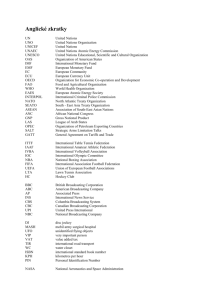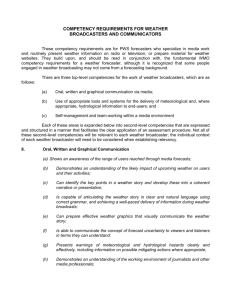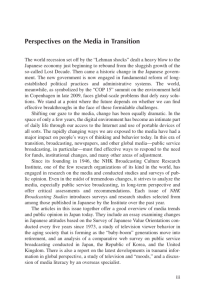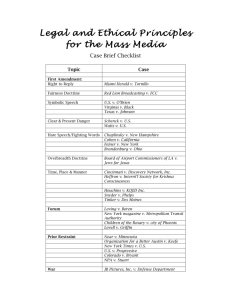The future of broadcasting in South Africa
advertisement
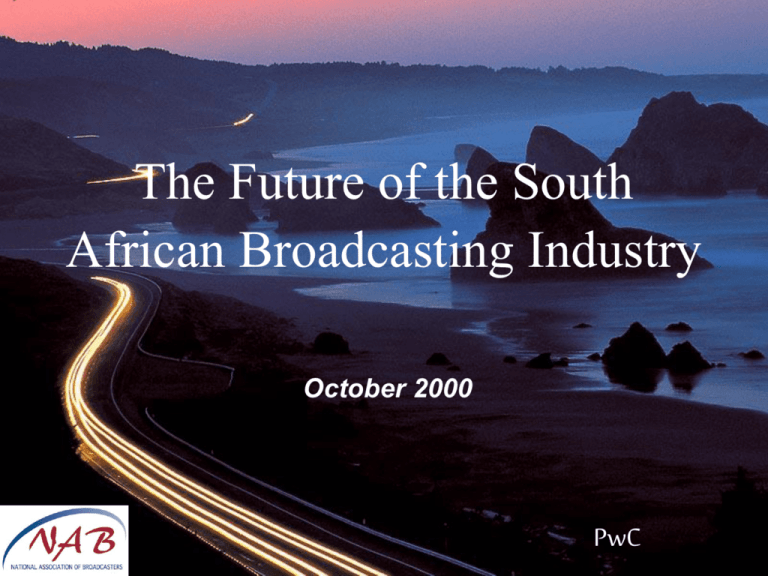
The Future of the South African Broadcasting Industry October 2000 PwC Introduction & Background PwC Introduction • The National Association of Broadcasters (NAB) wishes to thank you for the opportunity to make this presentation on the future of broadcasting in South Africa • This presentation is made at a time when South African broadcasting is not growing as it should • After the transformation of the industry post-94, it is our view that a second wave of intervention is needed to foster growth and development • This intervention could see the broadcasting sector realising its potential and driving our country into the new economy 3 Background to the presentation • The NAB, in conjunction with PricewaterhouseCoopers, have: – Conducted a survey amongst the television and radio broadcasters, as well as members of the investor community in South Africa and abroad; – Examined the key trends in media and broadcasting internationally; – Examined the status quo of the SA broadcasting industry; – Identified the critical success factors needed to promote growth in this industry; and finally – Made recommendations on the way forward • This presentation sets out our findings and attempts to address the key requirements to achieve growth in the broadcasting industry 4 The SA Broadcasting Industry PwC The status quo of the South African broadcasting industry • The media industry as a whole has been going through difficult times of late • Stock prices of media companies on the JSE have been depressed, a number of business failures have been reported and institutional investors seem reluctant to invest further capital into the industry • Since re-regulation there have been a number of changes in ownership, sometimes because assets were not delivering the returns anticipated. In fact, a recent survey by PwC confirmed that the majority of media companies in South Africa were destroying value • The public broadcaster has been going through a difficult financial period in the last couple of years • The regulator has sometimes not been able to meet the turnaround times in decisions called for by the marketplace 6 The SA media industry has out-performed because of a “first wave” of intervention, IPO’s and technology adoption Media Annual Total Shareholder Return (1997-1999) Composite 30% 15% UK USA SA However, this will only go so far... Source: PwC 7 Future value creation relies on a combination of growth and operating efficiency, which shows a “second wave” of intervention is required World South Profitability Africa 7% (18%) Operating World South Africa Efficiency (18%) (34%) World South Capital Africa Productivity (25%) (16%) Source: PwC 8 Total adspend in SA has remained relatively unchanged over the last 5 years between the various mediums… Adspend by medium: (last 5 years) 50% 45% 40% Percentage 35% 30% 25% 20% 15% 10% 5% 0% Print Source: Media Direction-OMD TV Radio Outdoor Cinema Knock & Drop 9 It is evident that the radio stations focusing on the upper LSMs have the highest share of revenue vs share of audience Share of Revenue vs Share of Audience 16% 14% 12% Percentage 10% % of Revenue % of Audience 8% 6% 4% 2% Source: PwC Analysis W hl ob o oo G FM en en e FM Ho p d Ta lk 2 70 e ad io m Kf ad io R St er eo m oa st 5f C Ea st R Um 94 .7 Hi gh ve Ja ld ca St ra er nd eo a 94 -9 7 FM R ad io M et ro Uk ho zi FM 0% 10 Radio Stations in the lower LSM groups have a large audience but generate a low share of revenue vs share of audience Share of Audience vs Share of Revenue 9% 8% Percentage 7% 6% 5% % of Revenue % of Audience 4% 3% 2% 1% Source: PwC Analysis tu s Lo R ad io 7 56 St er eo Sa fm Ta lk C ap e in g FM FM el a M ot sw ed Th ob on de rG re ns e a R ad io S R ad io Al go Yf m ra nj e O ad io R Le se di FM 0% 11 Which leads to a lot of questions for South African media players • What room is there to improve margins given that we are now equivalent to global benchmarks? • What can be done to drive more sales from the same capital base or reduce the capital base? • How can the market optimise returns of current and future capital outlays? • Can the media market sustain all the listed players? • How can regulation assist future growth and success for the market? • How do we achieve the objectives of empowerment, diversity and growth & investment? 12 Stakeholder Survey & Legislative Goals PwC From the survey, industry players believe that relatively little attention has been paid to growth and investment as a national goal Attention to goals, as reflected by the industry players 90% 80% 70% % Achieved 60% 50% 40% 30% 20% 10% 0% Growth & Investment Diversity Empowerment 14 Factors impacting on industry growth • Broadcasters identified the following factors as impacting negatively on industry growth: – Outdated ownership restrictions – Lack of transformation in the advertising industry – Sponsorship restrictions – Lack of flexibility and consistency in regulatory processes – Lack of viable licence opportunities for radio – Continued uncertainty about the SABC restructuring 15 Growth and investment is key for the achievement of national goals • South Africa’s broadcasting policy framework rests on the assumption that with a vibrant broadcasting industry, broader goals of diversity, empowerment, access, nation building, democratisation, education and foundation for a new economy will be established • It is the shared responsibility of government, the regulator and the different sectors of the broadcasting industry to meet these goals 16 Growth and investment and national goals • There is a commitment in national policy and legislation to: – Promoting free and fair competition so that the SA broadcasting system can be globally competitive (White paper, p11) – Encouraging investments in the broadcasting sector (White paper, p17) • The Competition Act also emphasises growth and investment in striving to: – Achieve a more effective and efficient economy in South Africa – Create greater capability and an environment for South Africans to compete effectively in international markets 17 Key International Trends PwC Globalisation and technological convergence are transforming the industry • Proliferation of media channels and formats have escalated the importance of content creation and ownership • Relaxed government rules and regulations have contributed to a wave of acquisitions and players have benefited by exploiting the cost and revenue opportunities from consolidation • There is increasing competition for advertising revenues from other media platforms, such as the Internet and outdoor advertising • Globally, there has also been an increasing demand for more niche oriented programmes 19 Based on global research, the following have been identified as critical success factors for broadcasters Technology & Synergy Ability to drive content through multiple and/or improved delivery systems and formats is necessary for maximising revenues off sunk development costs Managing Risk Larger, diversified revenue streams and asset bases offset risk and overhead expenses typical of the broadcasting industry Scale Larger firms have stronger purchasing power and greater clout with consumers, to stand up against international competition Quality of Assets Access to talent and quality of content determine revenue potential Capital Investment Access to equity financing and ability to service debt necessary for financing expansion programs and new product developments 20 For developing economies, however, the challenges are greater… This is because of: Which implies that: • The scale of the market • Consolidation is likely • The maturity of the media • Partnerships need to be • Limited technology and infrastructure development • Scarcity of skills explored • Additional markets should be identified • A flexible and stable regulatory • Pressing social objectives which environment is essential must also be achieved 21 How does South Africa measure against the global critical success factors? Technology & Synergy • A number of platforms but no licensing framework for multi-channel broadcasting • Unclear whether the ownership restrictions still apply • Foreign ownership is still capped at 20% • There is no roll-out plan for digital services Managing risk • Concentration limits impede investors • Non-tradability of assets increase risk 22 How does South Africa measure against the global critical success factors? Quality of assets • Local content quotas have seen a commitment to South African content • SA broadcasters’ access to quality content is affected by the prohibitive cost of local content • The local music industry does also not produce sufficient local music to accommodate the formats of stations • Human resource development has been prioritised -greater pool of available talent for broadcasters • May need more co-ordinated strategies 23 How does South Africa measure against the global critical success factors? Scale • Growth restricted by concentration limits and the cross-media limitations. • Regulator sometimes reluctant to licence up to maximum limit • In radio, no new licensing opportunities Capital Investment • Empowerment groups have sometimes found it difficult to access capital • There is no clear direction from policy makers on what is meant by empowerment 24 The Way Forward PwC What are the interventions needed to promote growth for the industry? Flexibility, responsiveness and predictability of national policy “In a fast moving area such as communications, it makes sense to have a regulatory framework that sets out key principles but can then adapt to circumstance” (UK Dept. of Culture, Media and Sport, 1999) • Other countries have recognised that this balance between flexibility and stability in broadcasting policy is key to meeting the challenges of the digital age: – In the US the FCC has a duty to review all telecommunications regulations every two years and repeal or modify rules no longer necessary – In Germany new laws must be tested one year after enactment to determine whether they are achieving their objectives • In this light, we have ten ideas intended to start dialogue on what could be done 26 The interventions needed to promote growth for the industry 1. Review the ownership restrictions • South Africa has companies with the capital to invest - they are discouraged • Best investors in broadcasting are broadcasters • Limitations conceived in 1993 - possibly outdated • Reviewing concentration restrictions would allow consolidation particularly among exiting radio players • Reviewing foreign ownership limitations would attract foreign investment particularly in capital intensive sectors 27 Interventions needed… 2. A plan for licensing of commercial radio • Greenfields licences were granted + four years ago - still only 6% market share • A creative new licensing effort could stimulate growth: – Could make available regional licences which combine viable areas with less viable, underserved areas – Could link licences to underused formats • A plan would give clarity on which licences, if any, will be issued over the next few years • Must be seen in tandem with ownership review - many existing players would not be able to participate if concentration limits aren’t reviewed 28 Interventions needed… 3. New options for local content rules • Broadcasters support SA content and the observation of quotas • When the quotas are reviewed there will be room for more flexibility in devising the kind of contribution broadcasters make to local content – Incremental increases over a period of years – Pay or play options – Staggered increases according to the type of service, format, genre and coverage – Credits for African content 29 Interventions needed… 4. Protection from additional levies • Broadcasters currently pay a number of levies • Proposed needletime levy will not solve problems of SA music industry • NAB committed to finding other solutions 5. Regulatory criteria and position on empowerment • Broadcasting industry has led empowerment • Recent setbacks - now only 5.9% of firms on JSE are black controlled • Need clear direction and criteria taking changed economic climate into account 30 Interventions needed… 6. Support for community radio • Community radio contributes to development, diversity and training • Has struggled to access financing • Pace of issuing 4 year licences has compounded difficulties • Need further strategies to alleviate burden 7. Framework for satellite broadcasting • Legal obstacles to regulation must be removed • Lack of regulatory certainty leads to instability in broader industry 31 Interventions needed… 8. Plan for digital services • Digital divide a threat to development • Broadcasting can assist in bridging the divide • Crucial that we develop a strategic framework sooner rather than later • SA has “e-leadership” - must maximise this to move forward on digitisation 9. Allow networking and syndication arrangements • A practical way for broadcasters to exploit synergies • Broadcasters are currently unable to fully exploit these possibilities • Could improve programme quality 32 Interventions needed… 10. Streamlining of regulatory processes • Awarding, amending and renewing of licences is time-consuming • Monitoring commitments are currently a burden to industry and regulator • Streamlining of these processes would be in everyone’s interests • Needs to be seen in the context of the adequate resourcing of the regulator 33 What about the industry’s responsibility? • The broadcasting industry is committed to working as a partner with policymakers in driving growth and transformation in this industry. • We, as industry representatives, therefore commit to: – Support policymakers in the achievement of the national goals for broadcasting – Work with policymakers on a job creation strategy for the industry – Support policymakers in a plan for digitisation – Produce internal codes and standards in line with the IBA’s recommendation of 1998 34 Conclusions & Discussions PwC

